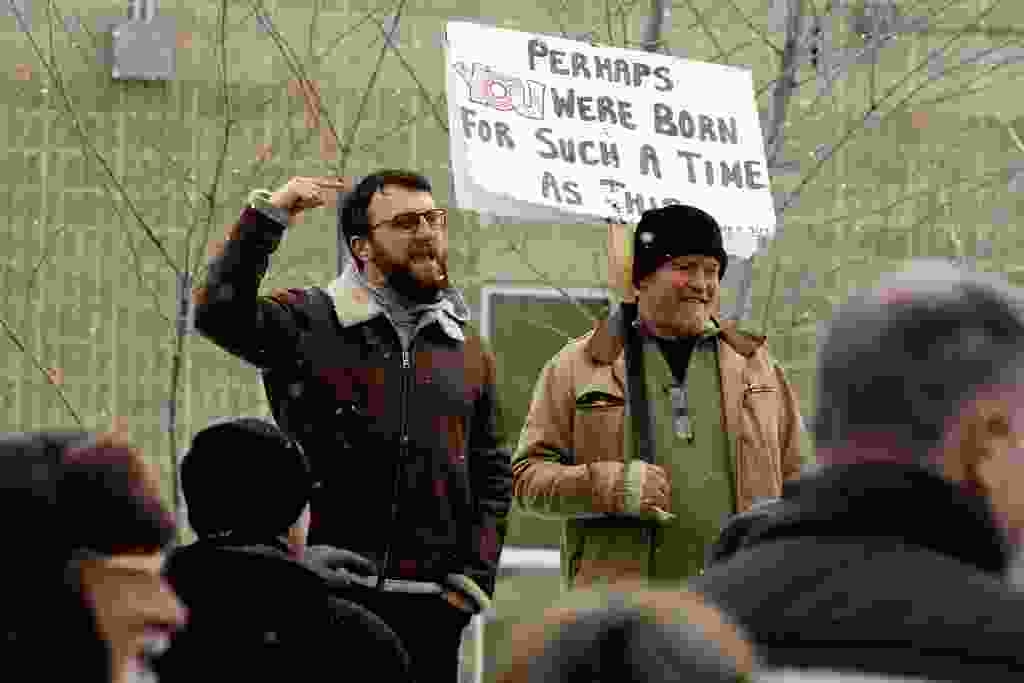Council voted to implement option 2, which adds towing services to the current enforcement model, with funding of $100,000 drawn from the council contingency fund for 2025.
 Street clearing continues in the east end of Edmonton on Jan. 7, 2025. Photo by Greg Southam /Postmedia, file
Street clearing continues in the east end of Edmonton on Jan. 7, 2025. Photo by Greg Southam /Postmedia, file Edmonton city council is reviewing four potential enforcement models aimed at improving compliance with parking bans during snow clearing and spring street sweeping.
The options, presented in an administration report, range from maintaining current staffing levels to expanding enforcement through external contractors, with proposed annual costs varying from $0 to $1.5 million.
This advertisement has not loaded yet, but your article continues below.

Subscribe now to read the latest news in your city and across Canada.
- Exclusive articles by David Staples, Keith Gerein and others, Oilers news from Cult of Hockey, Ask EJ Anything features, the Noon News Roundup and Under the Dome newsletters.
- Unlimited online access to Edmonton Journal and 15 news sites with one account.
- Edmonton Journal ePaper, an electronic replica of the print edition to view on any device, share and comment on.
- Daily puzzles, including the New York Times Crossword.
- Support local journalism.
Subscribe now to read the latest news in your city and across Canada.
- Exclusive articles by David Staples, Keith Gerein and others, Oilers news from Cult of Hockey, Ask EJ Anything features, the Noon News Roundup and Under the Dome newsletters.
- Unlimited online access to Edmonton Journal and 15 news sites with one account.
- Edmonton Journal ePaper, an electronic replica of the print edition to view on any device, share and comment on.
- Daily puzzles, including the New York Times Crossword.
- Support local journalism.
Create an account or sign in to continue with your reading experience.
- Access articles from across Canada with one account.
- Share your thoughts and join the conversation in the comments.
- Enjoy additional articles per month.
- Get email updates from your favourite authors.
Create an account or sign in to continue with your reading experience.
- Access articles from across Canada with one account
- Share your thoughts and join the conversation in the comments
- Enjoy additional articles per month
- Get email updates from your favourite authors
Parking bans are essential for ensuring roads are properly cleared of snow and debris, but officials say that when vehicles are left on the street, it delays operations, creates safety risks and hampers the effectiveness of maintenance crews.
The report, presented Monday during a council meeting, was prepared in response to a February motion directing administration to analyze fine structures, examine strategies for high-priority locations, and return with recommendations on how best to clear vehicles from city streets.
Existing approach stretched thin
Right now, enforcement is handled by five temporary municipal enforcement officers and one clerk who are deployed during winter parking bans. They focus solely on issuing tickets, since there is no budget allocated for towing or spring enforcement.
Communication with the public is handled through permanent and temporary signage, email alerts, social media and digital updates. City officials say while communication is crucial, consistent enforcement is key to changing behaviours.
This advertisement has not loaded yet, but your article continues below.
In 2022, the city raised the fine for parking ban violations to $250 from $100 and temporarily boosted enforcement staffing and towing capacity with a one-time $1.19 million budget from a larger $4.7 million investment aimed at improving snow and ice control. This funding supported 15 seasonal temporary enforcement officers, two temporary clerks and towing services at no cost to drivers, enabling a shift to proactive enforcement.
However, by early 2023, the budget was reduced to $274,000 annually, slashing staff and eliminating towing support, reverting the city to a limited enforcement model that remains in place today amid ongoing staffing challenges and rising service demands.
As council questioned whether the 27-day spring parking ban could be shortened by using a more targeted, quadrant-based strategy, city officials said that each area is already restricted for just one week. The city uses a leapfrogging approach across five districts, and sweeping is limited to weekdays between 7 a.m. and 5 p.m. due to equipment maintenance requirements.
This advertisement has not loaded yet, but your article continues below.
Even when towing was briefly reinstated in 2022-23, only 10 per cent of ticketed vehicles were actually towed due to contractor capacity limits and operational delays. The city used an existing contract with two vendors providing up to five trucks each, relocating 422 vehicles at a cost of about $55,000. Towed vehicles were moved to the nearest available street, and a tow location tool was made available online to help owners locate their cars.
Edmonton now relies on a single tow provider with no dedicated service under contract. In dense residential areas or zones with limited parking options, such as near schools or hospitals, enforcement is even more challenging.
Coun. Erin Rutherford said the broader structural issues at play also contribute to low compliance rates, pointing to physical limitations in some neighbourhoods.
This advertisement has not loaded yet, but your article continues below.
I think, ultimately, whatever the bylaw is, its meant to be about compliance. But what Im also reading in this report is theres some physical limitations to compliance in certain neighbourhoods, she said.
In response, a city official said enforcement could still make a difference if supported by the right tools, noting the city is developing a mapping tool to identify low-compliance areas using past violation data and neighbourhood design.
Enforcement would help if we had the towing capacity to be able to remove those vehicles from the high density areas. Ticketing would change behaviour over time, but again, towing would be the best option in those higher density neighbourhoods, said a city official during Mondays meeting.
Still, city officials acknowledge enforcement coverage is limited across Edmontons 12,000 kilometres of roadway.
This advertisement has not loaded yet, but your article continues below.
Administration outlined the following options for council consideration:
- Option 1: status quo: Maintains five temporary officers focused on winter ticketing only. No towing or spring enforcement. Cost is $0 additional funding.
- Option 2: current staffing with towing: Adds towing services to the current model. About five per cent of violators would be towed to a nearby street by contractors. Cost is estimated at $100,000 additional annually.
- Option 3: enhanced staffing with towing contract: Restores 2022-23 staffing levels, expanding the team to 15 officers, two clerks and a supervisor. It includes towing and some proactive sidewalk enforcement when bans are not in effect. Cost is estimated at $1.1 million additional annually.
- Option 4: outsourced enforcement and towing: Shifts all enforcement and towing to external contractors, enabling seven-day-a-week operations. Risks include less city control and potential inconsistencies. Sidewalk enforcement not included. Cost is estimated at $1.5 million additional annually.
This advertisement has not loaded yet, but your article continues below.
Coun. Andrew Knack said he supports testing the approach and ultimately sees option 4 as the ideal long-term direction.
I think we need to try this, he said. This is definitely not going to solve where we need to be but at least if we do it this way, it can give us a bit of a better sense of how we can get to that point, what the results would be and move us in the right direction to help out with our crew.
Need for stability and long-term planning
Officials say that shifting enforcement strategies year to year has made it difficult to evaluate what works. A multi-year approach is needed to collect consistent data and adapt policies based on performance.
The report also includes a jurisdictional scan of other Canadian cities, such as Calgary, Ottawa, Halifax and Winnipeg, showing a wide range of enforcement practices, fine structures and towing strategies.
This advertisement has not loaded yet, but your article continues below.
Rutherford said she has concerns over the ongoing inconsistency, and that she didnt love any of the options, not because theyre not great options. I just think continually changing this programming year over year over year hasnt helped with communication, hasnt helped with consistency.
Council motions
Council voted to implement option 2, which adds towing services to the current enforcement model, with funding of $100,000 drawn from the council contingency fund for 2025. Administration is expected to return during the fall supplemental budget process with a proposal for ongoing funding.
In addition, Rutherford brought forward a motion to amend the parking bylaw fine structure, proposing to reduce fines for parking ban violations to $150 from $250, with an early payment option further lowering the fine to $100 if paid within seven days, which was carried.
Bookmark our website and support our journalism: Dont miss the news you need to know add EdmontonJournal.com and EdmontonSun.com to your bookmarks and sign up for our newsletters .
You can also support our journalism by becoming a digital subscriber. Subscribers gain unlimited access to The Edmonton Journal, Edmonton Sun, National Post and 13 other Canadian news sites. The Edmonton Journal | The Edmonton Sun
 Cult of Hockey
Cult of Hockey  Politics
Politics  Cult of Hockey
Cult of Hockey  Sports
Sports  Sports
Sports 

